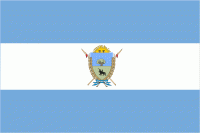La Pampa Province (La Pampa Province)
 |
 |
In 1604 Hernando Arias de Saavedra was the first European explorer to reach the area; it was later explored by Jerónimo Luis de Cabrera in 1662. But it was not until the 18th century that Spanish colonists established permanent settlements here.
Resistance of the local indigenous people prevented much expansion until the government of Juan Manuel de Rosas. It did not cease until Julio Roca's conquest of the desert in the 19th century. The territory was divided between the officers, and they erected the first Argentine settlements.
The Territorio Nacional de La Pampa Central was erected in 1884, containing the Río Negro Province and parts of other surrounding provinces. It had around 25,000 inhabitants. By 1915 there were 110,000 residents, a reflection of movement to that area. In 1945 the territory was divided and La Pampa became a province.
In 1952 its constitution was written and the province was renamed after Eva Peron. In 1955 after the government changed and the Peróns went into exile, both La Pampa and Chaco, which had been named for Juan Perón, were reverted to their original names.
Map - La Pampa Province (La Pampa Province)
Map
Country - Argentina
 |
 |
| Flag of Argentina | |
The earliest recorded human presence in modern-day Argentina dates back to the Paleolithic period. The Inca Empire expanded to the northwest of the country in Pre-Columbian times. The country has its roots in Spanish colonization of the region during the 16th century. Argentina rose as the successor state of the Viceroyalty of the Río de la Plata, a Spanish overseas viceroyalty founded in 1776. The declaration and fight for independence (1810–1818) was followed by an extended civil war that lasted until 1861, culminating in the country's reorganization as a federation. The country thereafter enjoyed relative peace and stability, with several waves of European immigration, mainly Italians and Spaniards, radically reshaping its cultural and demographic outlook; over 60% of the population has full or partial Italian ancestry, and Argentine culture has significant connections to Italian culture.
Currency / Language
| ISO | Currency | Symbol | Significant figures |
|---|---|---|---|
| ARS | Argentine peso | $ | 2 |
| ISO | Language |
|---|---|
| EN | English language |
| FR | French language |
| DE | German language |
| GN | Guarani language |
| IT | Italian language |
| ES | Spanish language |















